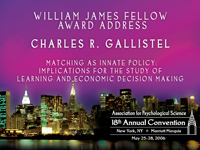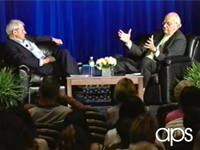Making Sense of Terrorism
It is far easier to interview New Yorkers about 9/11 than it is to interview Osama bin Laden about why he does what he does. For that obvious reason, “The Psychology of Terrorism,” a collection of themed programs that bridged various disciplines within the field, skewed towards the psychology not of terrorists, but of the terrorized. When there is such hunger for answers, it makes sense to devour the low-hanging fruit first. This was one of three themed cross-cutting programs making a debut as a new feature of the APS 18th Annual Convention.
In the terrorism program, a symposium on terrorism-related psychology focused on the questions on everyone’s mind: What creates a terrorist? How do we understand reactions to terrorism? How do we protect against future attacks? Researchers have been trying to understand terrorism with the standard models of motivation and judgment that psychologists trust in non-terrorist scenes.
Arie Kruglanski, co-director of START (National Consortium for the Study of Terrorism and the Response to Terrorism) considered the question of what motivates individuals to become terrorists. He explained that recent analyses of this issue reveal that terrorists’ motivations are highly diverse. Some motives, Kruglanski said, are highly personal and individualistic (a loss of a loved one, the wish to redeem a tarnished reputation). Other motives are collectivistic and ideological (freedom from oppression, social justice, serving God’s will).
The kinds of motives researchers uncovered depend in part on their method of analysis. Researchers who tapped official sources (pronouncements of terrorists or of terrorist organizations) typically concluded that terrorists’ motivations are ideological. Researchers who delved into the circumstances of terrorists’ activities typically came up with personal motives. However, both types of motives are likely to play a role in fueling individuals’ readiness to join a terrorist organization or embark on a terrorist mission. Ideological reasons lend significance and importance to one’s actions, as well as imbue them with profound meaning, Kruglanski said. Additionally, to embark on a terrorist mission often requires personal trauma resulting from loss, frustration, and hopelessness. Given this analysis effective counterterrorism efforts should be two pronged: reduce the motivational factors that compel individuals to choose terrorism while stripping terrorism activities from their ideological justifications.
In a deft reaction to the inaccessibility to actual terrorists, Clark McCauley, professor of psychology at Bryn Mawr College, a director of the University of Pennsylvania’s Solomon Asch Center for Study of Ethnopolitical Conflict, and a co-director of START, reinforced the idea that terrorists are the apex of a much larger social support structure made from a pyramid of supporters and sympathizers. With a focus on the psychology of suicide bombing, McCauley pointed out a key difference between individual and group motives. Individuals are often tied to individual motives, such as vengeance, or immortality. But motives of a terrorist group are more likely to be tied to larger strategies and values.
Jujitsu Politics
McCauley also quoted terrorism researcher Mia Bloom who brands one motivation of terrorism as “jujitsu politics,” using the strength of an enemy to contribute to that enemy’s downfall. In this psychological approach, a big response from the enemy is designed to mobilize sympathizers to action behind terrorist leadership – and, McCauley pointed out, like-mindedness has a natural inclination towards extreme goals as well as extreme tactics.
Jeff Victoroff, a professor of clinical neurology and psychiatry from the University of Southern California, pointed out how flimsy much of the research into the psychology of terrorism actually is. Just to prove his point, he and his graduate students analyzed the abstracts of 1808 peer-reviewed papers allegedly on terrorism published over the past 35 years, and read 400 of the most promising articles. Only 18 (or less than 1 percent of the total) actually reported empirical work on the psychology of terrorists, and most of those papers depended on things like newspaper articles and trial transcripts as their primary sources.
Victoroff criticized the frequent use of what he called “spaghettigrams” in the field, cluttered convergences of variables. In sync with McCauley’s pyramid model, Victoroff noted that sympathy for terrorists is necessary for maintaining their causes, but not sufficient; there must also be this larger social base.
In one of the tougher situations related to the psychology of terrorism, Frank Yates, University of Michigan, addressed the issue of how to warn people about terror alerts without the alerts themselves serving to terrorize. Displaying the familiar rainbow-colored terror warning system used by the Department of Homeland Security – which has never lowered the bar to the green and blue safe levels – Yates said, “the warning system effectively uses powerful psychological principles to induce in people the sense that they are at great risk of terror. Thus, unless the system is used wisely, it can, perhaps unwittingly, do the terrorists’ work for them.”
Of particular interest, given the conference’s location, was a talk by Elizabeth Phelps, a memory researcher at New York University, on the differences in the experiences of 9/11 between New Yorkers and other Americans, as well as between those New Yorkers who lived near the attacks and those who did not. Phelps analyzed “flashbulb memories” – memories often described in popular lingo as being “burned in,” such as traumatic events such as the Kennedy assassination, John Lennon’s assassination, the Challenger explosion, and, of course, 9/11.
Using responses from the 9/11 Memory Consortium, a national memory survey on the terrorist attacks, Phelps determined that New Yorkers were more confident in their memories and more accurate about some of the details – both objective facts such as where people were and how many planes hit, as well as emotional facets such as what effect the attacks had on themselves and others. She also reported brain imaging results suggesting that memories of 9/11 differed depending on where you were in New York City during the attack. New Yorkers who were downtown, closer to the disaster, reported a more vivid memory experience and engaged different underlying neural circuitry compared to New Yorkers who were in midtown.
But perhaps most indicative of the larger approach of psychology toward terrorism is the “terror management theory,” presented by Tom Pyszczynski, University of Colorado at Colorado Springs. He described the “double-barreled attack” that terrorism brings: “When you are forced to confront death, you’re forced to confront why the safeguards that protect you from thinking about death failed.” In this way, Pyszczynski argued, events such as 9/11 mean that “even thought we don’t show signs of post-traumatic stress disorder, we are all traumatized.”




APS regularly opens certain online articles for discussion on our website. Effective February 2021, you must be a logged-in APS member to post comments. By posting a comment, you agree to our Community Guidelines and the display of your profile information, including your name and affiliation. Any opinions, findings, conclusions, or recommendations present in article comments are those of the writers and do not necessarily reflect the views of APS or the article’s author. For more information, please see our Community Guidelines.
Please login with your APS account to comment.